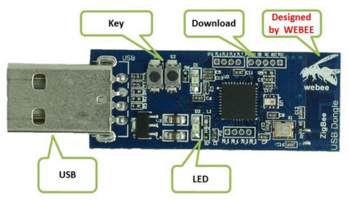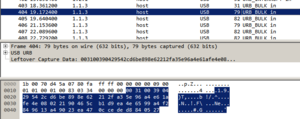CC2540: Difference between revisions
Put USB control transfers in a table |
move images |
||
| Line 94: | Line 94: | ||
== Protocol == | == Protocol == | ||
[[File:cc2540_settings.png|right|thumb]] | |||
[[File:cc2540_packet_details.png|thumb]] | |||
[[File:cc2540_wireshark.png|thumb]] | |||
In the windows sniffer software, it seems there are only two things communicated: | In the windows sniffer software, it seems there are only two things communicated: | ||
* towards the stick: which radio channel to sniff, and some other radio settings | * towards the stick: which radio channel to sniff, and some other radio settings | ||
| Line 99: | Line 102: | ||
=== Configuring the radio === | === Configuring the radio === | ||
This appears to be done using USB control transfers. | This appears to be done using USB control transfers. | ||
| Line 127: | Line 129: | ||
=== Reading BLE frames === | === Reading BLE frames === | ||
This appears to be done using USB bulk input transfers. | This appears to be done using USB bulk input transfers. | ||
Revision as of 11:08, 18 November 2016
| Project CC2540 | |
|---|---|

| |
| Making the CC2540 BLE dongle work | |
| Status | In Progress"In Progress" is not in the list (Proposed, Initializing, In progress, Completed, Stalled, Abandoned) of allowed values for the "Project Status" property. |
| Contact | bertrik |
| Last Update | 2016-11-18 |
Introduction
This page is about the CC2540 bluetooth low-energy sniffer dongle and getting it to work with Linux. A nice end result could be that it becomes possible to sniff directly in WireShark with this dongle.
I have such a "WeBee" dongle that can be found for about E15,- on websites like Aliexpress.
It's supposedly a CC2540 (or compatible) dongle, the USB id is 0451:16b3.
Interesting links:
- https://lacklustre.net/bluetooth/wireshark.html
- http://processors.wiki.ti.com/index.php/BLE_sniffer_guide
- https://github.com/andrewdodd/ccsniffpiper
Analysis
USB descriptor
When plugging this stick into a Linux machine, you can see it uses only one bulk endpoint.
Bus 001 Device 009: ID 0451:16b3 Texas Instruments, Inc.
Device Descriptor:
bLength 18
bDescriptorType 1
bcdUSB 2.00
bDeviceClass 0 (Defined at Interface level)
bDeviceSubClass 0
bDeviceProtocol 0
bMaxPacketSize0 32
idVendor 0x0451 Texas Instruments, Inc.
idProduct 0x16b3
bcdDevice 90.07
iManufacturer 1 Texas Instruments
iProduct 2 CC2540 USB Dongle
iSerial 0
bNumConfigurations 1
Configuration Descriptor:
bLength 9
bDescriptorType 2
wTotalLength 25
bNumInterfaces 1
bConfigurationValue 1
iConfiguration 0
bmAttributes 0x80
(Bus Powered)
MaxPower 100mA
Interface Descriptor:
bLength 9
bDescriptorType 4
bInterfaceNumber 0
bAlternateSetting 0
bNumEndpoints 1
bInterfaceClass 255 Vendor Specific Class
bInterfaceSubClass 255 Vendor Specific Subclass
bInterfaceProtocol 255 Vendor Specific Protocol
iInterface 0
Endpoint Descriptor:
bLength 7
bDescriptorType 5
bEndpointAddress 0x83 EP 3 IN
bmAttributes 2
Transfer Type Bulk
Synch Type None
Usage Type Data
wMaxPacketSize 0x0040 1x 64 bytes
bInterval 5
Device Status: 0x0000
(Bus Powered)
USB logs from Windows
This USB device does actually work with Windows:
I've captured a log of the communication over USB while the BLE is capturing bluetooth traffic from some iBeacon, using USB pcap.
In the logs, I cannot see any firmware blobs being downloaded to the stick. Probably the stick comes with a pre-loaded firmware of itself to do the BLE sniffing.
The USB control transfer request codes seem to match up with the code in https://github.com/christianpanton/ccsniffer/blob/master/ccsniffer.py
- 0xC0, GET_IDENT: returns some kind of identifier
- 0xC5, SET_POWER
- 0xC6, GET_POWER
- 0xC9, no idea, this appears in my USB logs but I can't find it in the python code
- 0xD0, START
- 0xD1, STOP
- 0xD2, SET CHAN
Protocol



In the windows sniffer software, it seems there are only two things communicated:
- towards the stick: which radio channel to sniff, and some other radio settings
- from the stick: raw sniffed BLE frames
Configuring the radio
This appears to be done using USB control transfers.
The following requests are sent:
| Request type | Request | Value | Index | Data | Description |
|---|---|---|---|---|---|
| 0x40 | 0xC5 | 0 | 4 | - | Set power |
| 0xC0 | 0xC6 | 0 | 0 | 0x00 | Get power |
| 0xC0 | 0xC6 | 0 | 0 | 0x04 | Get power |
| 0x40 | 0xC9 | 0 | 0 | - | ??? |
| 0x40 | 0xD2 | 0 | 0 | 0x27 | Set channel |
| 0x40 | 0xD2 | 0 | 1 | 0x00 | Set channel |
| 0x40 | 0xD0 | 0 | 0 | - | Start capture |
Reading BLE frames
This appears to be done using USB bulk input transfers.
I can see a lot of similarities between the USB log and the BLE sniffer log. The bulk USB data starts off with two bytes indicating the length of the rest of the data.
Software
Preliminary code can be found at https://github.com/bertrik/cc2540
It connects to the dongle and dumps raw USB packets to stdout.
This software requires libusb-1.0-dev